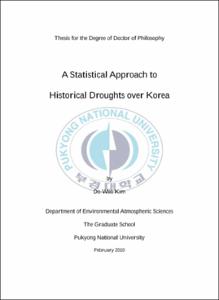A Statistical Approach to Historical Droughts over Korea
- Abstract
- In this thesis, an attempt has been made to study the severity of drought and drought climatology of Korea. For this purpose statistical methods have been applied on long-term precipitation data of Korea from 1777 to 2008. To select a fundamental drought index, the performances of the Effective Drought Index (EDI) and 1-, 3-, 6-, 9-, 12-, and 24-month Standardized Precipitation Indices (SPIs) were compared by using the precipitation data in Seoul. It has been found that the EDI is more efficient than the SPIs in assessing both short and long-term droughts.
This study have also examined the common limits of existing drought indices including EDI and suggested the improved techniques for monitoring drought more accurately: 1) CEDI, a corrected EDI that considers the rapid runoff of water resources after heavy rainfall; 2) AEDI and YAEDI, a cumulative EDI that quantifies the severity of droughts by event and by year, respectively. In order to diagnose and estimate the intensity of drought more accurately, it was proposed the utilization of 3) the Available Water Resources Index (AWRI), an existing index that expresses the actual amount of water available, in addition to the indices mentioned earlier.
This study expanded its focus from the drought assessment on specific region to the assessment on the drought climatology in Korea. For this purpose Korea has been divided into four drought sub-regions (central, southern, east coast regions and Jeju Island) based on the similarity of drought characteristics (i.e., onset date, duration, and severity). The long-term drought maps have been prepared, which allow to indentify the spatiotemporal distribution of droughts for 231 years at a glance. It has been found that a total 123 droughts occurred with periodicities 5, 14, 34, and 116 years. 5 year periodicity was dominant over all the regions. 14 and 34 year periodicity was observed over the southern and east coastal regions and the central region, respectively.
Return period of 123 droughts has been estimated using the bivariate (severity and duration) nonparametric method. The most extreme drought occurred in 1899-1903 (return period: 207 years) associated with 116 year periodicity. After this drought, severe droughts (return period > 10 years) occurred in 1927-1930, 1938-1940, 1942-1945, 1951-1953, 1967-1969, and 1994-1996 (associated with 5 and 14 year periodicities).
- Issued Date
- 2010
- Awarded Date
- 2010. 2
- Type
- Dissertation
- Publisher
- 부경대학교
- Department
- 대학원 지구환경시스템과학부환경대기과학전공
- Advisor
- 변희룡
- Degree
- Doctor
- Appears in Collections:
- 대학원 > 지구환경시스템과학부-환경대기과학전공
- Files in This Item:
-
-
Download
 A Statistical Approach to Historical Droughts over Korea.pdf
기타 데이터 / 3.84 MB / Adobe PDF
A Statistical Approach to Historical Droughts over Korea.pdf
기타 데이터 / 3.84 MB / Adobe PDF
-
Items in Repository are protected by copyright, with all rights reserved, unless otherwise indicated.